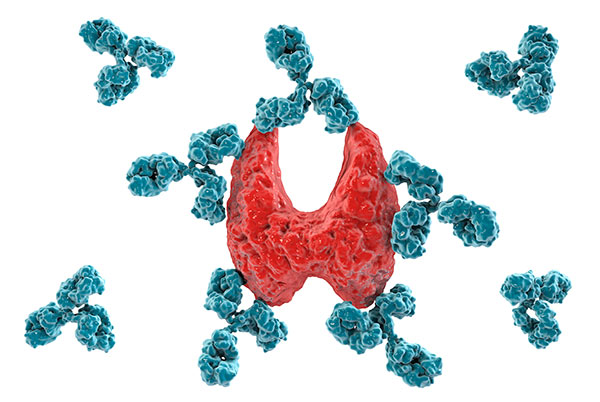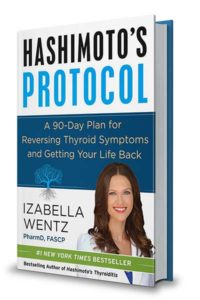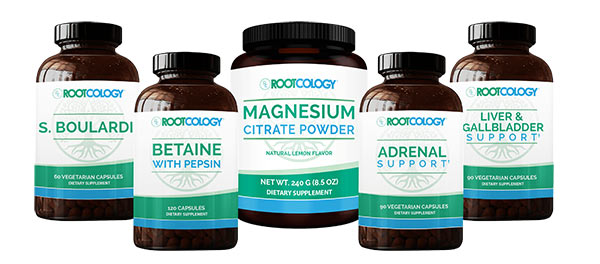
The Hashimoto’s Protocol
My Experience with Diet, Lifestyle & Supplement Interventions
By Malory Speir
After nine years of working at Gluten Free & More and hearing from countless readers, I’m still fascinated and inspired when I hear stories about how they solved everything from psoriasis to migraines to infertility and more by going gluten-free and/or making other lifestyle adjustments. Which is why, when I found out I have Hashimoto’s, my first thought was to go gluten-free. Prior to being diagnosed, I had read numerous articles for the magazine about the connection between Hashimoto’s and gluten, and I thought that it would for sure reverse this condition.
It’s a little more complicated than that.
Hashimoto’s thyroiditis is an autoimmune disease where your very confused immune system decides it’s going to attack your thyroid. Talk about self-sabotage. Your thyroid controls your metabolism and tells your body how to use energy, which impacts everything from your heart rate to digestion to energy levels to mood and more.
Hashimoto’s, like most autoimmune diseases, is caused by a genetic predisposition to have the disease combined with a trigger (or multiple triggers) that “turn on” that gene. Gluten is the known trigger for celiac disease, but for most other autoimmune diseases, triggers are a mystery and are not universal. There are ways of finding out what triggered your disease and treating that underlying issue (a virus, for example) or avoiding that trigger (a particular food, for example), however it’s not always easy and you might not ever find the answers you need. However, many people have been successful in finding answers and putting their condition(s) in remission, so I think it’s best to at least try to get to the bottom of your trigger(s) than to only treat the symptoms.
With Hashimoto’s, the conventional medicine approach is to test your thyroid antibodies and your thyroid hormones. If you only have the antibodies and your hormones are in normal range (like me) you wait, and they monitor you with tests after some months and see what happens. If you have symptoms or if your hormone levels are not in the normal range, they give you thyroid medication. Thyroid medication can slow down the autoimmune progression and it helps many, many people and it may one day help me, too. But I’ve heard that many people still have Hashimoto’s symptoms despite taking medication, so I’m not convinced it’s the one and only thing you should do to help yourself. I think it’s just one of the many tools. My logic is this: Hashimoto’s isn’t the same as “regular” hypothyroidism or hyperthyroidism; it stems from your immune system, not your thyroid. Your thyroid is the victim, and your immune system is the assailant. You need to help the victim recover, absolutely, but don’t you also need to stop the assailant from continuing the attack or at the very least lessen the blows from the assailant?
Now that I’ve given you some general information about Hashimoto’s and my overall philosophy of health and other ramblings, let’s get down to it. This article is about my experience with the healing protocols in Dr. Izabella Wentz’s book, The Hashimoto’s Protocol. First, let me touch on what my test results were initially.
I was first tested for Hashimoto’s in October 2019 after I developed hives (I thought it was an allergic reaction, but my allergy/asthma doctor thought otherwise and had me tested – kudos to her!). My thyroid peroxidase antibodies were 538 but my TSH thyroid hormone was in the normal range at 2.36 (most labs place the normal range at 0.5 to 4.5, but newer studies have suggested the optimal range is 0.5 to 2.5). My free T4 was 1.2 (0.8 to 1.8 is normal; 1.3 to 1.8 is optimal) and free T3 was 2.9 (2.3 to 4.2 is normal; 3.2 to 3.3 is optimal).
At my first endocrinology appointment, the doctor confirmed what I already knew, that a gluten-free diet could potentially help, though it’s not a guarantee. Because my hormone levels were within the normal range, and I was mostly asymptomatic (the hives had gone away and the only symptom I really have now is fatigue) he decided to monitor my levels every so often and eventually he may put me on medication.
The next week I began a gluten-free diet.
My follow-up in October 2020 showed that my antibody levels were 696, my TSH was 2.21, my free T4 was 1.2, and for some reason my free T3 wasn’t tested. At this appointment, I met with the physician’s assistant. I discussed with her my desire to try diet changes, supplements, and lifestyle interventions and I mentioned to her that I had started a gluten-free diet. She was receptive to this and suggested I read The Hashimoto’s Protocol.
The next week I bought the book.
I officially started the protocol in February 2021.
So, what exactly are the protocols? Without giving away too much of the book itself, here’s a brief rundown.
The first stage of the protocol is for Liver Support. It involves avoiding gluten, dairy, sugar, soy, caffeine, and alcohol, and taking supplements that help support your liver function, eating foods that help support detox pathways, and cleaning up your environment and personal care items. Dr. Wentz provides a list of toxins to look for in personal care products. This protocol lasts two weeks.
The second stage of the protocol is for Adrenal Support. It involves avoiding the same foods from the liver protocol, plus no grains, seaweed, or legumes (except green beans and peas), and taking supplements to support your adrenals. The biggest part of this protocol, aside from food and supplements, is lifestyle changes including trying to sleep for 10 hours a night and doing stress-relieving activities like meditation, reading, and spending time in nature. I was able to shift my work schedule by one hour to try to get 10 hours of sleep a night, I was going on walks regularly, and overall, I felt the best during this stage. This protocol lasts four weeks.
The third stage of the protocol is for Gut Support. This is the most challenging as far as diet. It involves avoiding the same foods as the adrenal protocol, plus no nuts, seeds, nightshades, and peppers – this includes no seed- or pepper-based spices like cumin and chili powder. Essentially, it’s a full Autoimmune Protocol (AIP) diet. This protocol also includes taking supplements that help heal leaky gut, like L-glutamine, enzymes, and probiotics, and eating foods like fermented foods and bone broth. This protocol lasts six weeks but technically it ends up being a lot longer than that, at least with the diet portion, because you have to slowly reintroduce foods one by one.
The book doesn’t provide details about reintroductions, but Dr. Wentz has supplemental chapters and guides on her website at thyroidpharmacist.com/action and reintroductions are explained there. I didn’t know this at the time and found the info elsewhere for AIP reintroductions. Either way, there is plenty of information about AIP reintroductions all over the internet for this, and lots of websites with delicious AIP recipes to make things easier.
What I learned & what I liked most:
This is a guidebook that teaches you about the potential triggers and underlying causes of your thyroid condition, how to optimize your thyroid hormones, lifestyle and diet interventions, and more. It’s helpful in many ways, at any stage in your journey with Hashimoto’s.
The book opens you up to a different way of thinking about health conditions because it leads you on a path to discovering what makes you well, what makes you sick, and the many avenues you can try to take to improve your health. It helps to show you that if one thing doesn’t work for you, be it medicine or diet or supplements, there’s almost always another option you can try because health is custom, not one-size-fits-all. Since a medicine-only approach doesn’t always work for people with Hashimoto’s, as I mentioned previously, having information at your fingertips about the whole-body approach (diet, lifestyle, addressing underlying issues, etc.) to use alongside medication is immensely helpful.

If you’re anything like me, you will probably have more questions after reading the book than you had before, not because it’s missing information – on the contrary, it’s because you’ll learn so much about the condition, more than you thought there was to know, and that will cause you to have lots of questions – namely “what are my triggers?” It’s then up to you to be detective for your own body. You might decide to get tested for things like parasites or nutrient deficiencies if those issues seem to resonate with your experiences, or at the very least you will start to be more in tune with your body and will notice what seems to have the most impact on your symptoms.
I believe that we are our own best advocates – we live in our own bodies and know what we feel like every day, and I like that this book recognizes that and helps to empower us to try our best to take back our health.
What I do want to mention, is that the diet portion of the protocol can cause you stress, and more stress can cause an exacerbation of autoimmune disease symptoms. However, the amount of the stress the diet gives you will likely not outweigh its benefits. The success of how you handle the diet will depend on factors like how unhealthy your diet was before, how often you meal prep, how good you are at making something out of almost nothing at the last minute when hunger strikes, how well equipped your kitchen is to be able to regularly make meals, and whether or not you have to feed people in your household who will not participate in your diet.
If you go into the diet with an adventurous mindset of trying new foods and breaking out of the ordinary meals you’re used to having, then you should be fine. I started regularly eating foods I didn’t used to eat a lot of, like bananas and shrimp, and I tried new foods like tigernuts, and I relied heavily on foods like coconut, cassava, and plantains to create alternatives to foods I was used to eating.
Did the Hashimoto’s Protocol work for me?
I’ll be honest, as I was doing the protocols I had a twinge of worry in the back of my mind – what if my numbers are worse and I have nothing to show for it? I figured I wouldn’t write the article if that were the case! So, of course, I was thrilled – not only for the sake of my article but more importantly for my health and for all my hard work and energy spent on the protocols – when I saw that my antibodies went down by almost half! From 538 in October 2019, to 696 in October 2020, to 374 in April 2021. My other numbers in April 2021 were: 1.87 TSH, 1.3 free T4, and 2.9 free T3.
Something worked! Was it the diet? The supplements? Both? That’s the hard part – determining what worked best and what didn’t make a difference. Do I need to be dairy-free the rest of my life or did dairy not have an impact since I didn’t get any symptoms when I reintroduced it? Which of the many supplements do I continue taking? This is where the reintroduction of foods is important. You must really pay attention to how you feel. So far, I’ve had a possible reaction to egg yolks and potatoes, but I plan to reintroduce those at a later date to see if I still have issues with them.
If you’re like me and are mostly asymptomatic and/or didn’t have a lot of noticeable reactions to foods, it’s hard to tell what your triggers are, so in my case I will see what my labs look like in August 2021, which by that time I will have finished the reintroduction process. Unfortunately, I’ve been under some unexpected stress lately, so if my numbers go back up, I won’t know if it’s from reintroducing foods or from the stress, or both. In my opinion, this will be an ongoing process for a while to determine what works best for me, and it might involve some testing for parasites, viruses, nutrient deficiencies, and other things that could have triggered the condition. My main symptom – possibly my only symptom – is fatigue, which I believe is stemming from my adrenals, so I plan to focus heavily on the information in the Adrenal Support chapter once I’ve finished my reintroductions.
My Hashimoto’s is not in remission, but an improvement in my antibody numbers and a continuation of stable hormones makes me feel like I am on the right track.
Challenges of the protocol & advice I’d give to those trying it:
Personally, I think the best first step after reading her book is to bookmark each of the protocol summaries included at the end of each protocol, take notes about what you personally need to do (maybe you’re already gluten-free and dairy-free, so then you just make a list of the other foods to eliminate during each protocol and put your list on the fridge to remind yourself). Find out which supplements you might already have and which ones you’ll need to buy. Buy all the supplements you need before you start each protocol.
The brands of supplements I used were Rootcology, Pure Encapsulations, Standard Process, Jarrow, NOW, Designs for Health, and Thorne. The supplement part of this process can be pricey, so I suggest you look at places like The Vitamin Shoppe and become a member. You get rewards points and often coupons in the mail, plus I’ve found that my local Vitamin Shoppe stores will price match with competing stores, including Amazon – you just have to ask. Most of the brands I mentioned here are not available at The Vitamin Shoppe, but some of them are.

Meal prep. Meal prep. Meal prep. I can’t say it enough and frankly I didn’t even meal prep as much as I should have, so I’d like for you to learn from my failure!
Try different AIP recipes and different AIP products – flours, snacks, etc. otherwise you will be eating the same thing quite often and it will get boring, make you feel hangry and want to cheat, and frankly, you need the diversity that multiple different foods bring to your microbiome and your palate!
Keep enough fruits and veggies on hand for you to snack on when there’s not much else to reach for. A banana with tigernut butter is divine and is a nice alternative to desserts when you want something sweet.
Smoothies are your friend. Learn to like them. I would have starved some days if not for protein powder, frozen fruit, and my beloved blender.
Brands that make AIP products:
If not for some delicious AIP-friendly products, I would have probably cheated or quit this diet or at the very least had a real bad attitude from being hungry. Here are some products I liked.
- AiPeazy baking mixes, hot “cereal” and muesli
- Artisana coconut butter
- AutoimmuniTea herbal tea blends
- Big Tree Farms coconut aminos
- Cocojune Pure Coconut Milk Yogurt (if I had to guess, 98 percent of coconut milk yogurts contain a non-AIP ingredient like rice starch; this is one of the only AIP friendly yogurts I found)
- EAT Gangster cookie mixes
- GT’s Aqua Kefir (this was my replacement for kombucha since you can’t have caffeine on the protocol)
- Jovial Grain-Free Cassava Pasta (great for quick meals; the orzo is my favorite)
- KC Natural tomato-free sauces (a life saver for go-to favorites like barbecue chicken; try the mustard-free “mustard” sauce mixed into Jovial orzo and a medley of roasted vegetables like broccoli, zucchini, carrots, and butternut squash)
- Legit Bread Company baking mixes (the bagels helped curb a gnarly carb craving I had when I first ditched the grains)
- Otto’s Cassava Flour
- Paleo Angel power ball treats (these are perfect for sweets cravings)
- Primal Palate seasoning blends (they have a specific line that is AIP friendly)
- Roots tigernut butter (this goes great on sweet potato “toast” and on bananas)
- Tiger Nuts USA (if you’ve never had tiger nuts, they aren’t a nut and they are used as an AIP flour)
- True Primal soups (this saved me on many busy workdays when I needed a quick and filling lunch)
Disclaimer: I am not a doctor or medical professional. This is my personal experience trying some health protocols that I wanted to share with you. I offer no medical advice, just some helpful tips if you follow Dr. Wentz’s protocol yourself. The choice to follow her protocol and write this article was 100 percent my decision, though I did request and receive samples of her Rootcology supplements. I also received samples of many AIP-friendly products, though I only included the ones that I personally recommend.
As always, consult a medical professional before beginning any new protocol.

